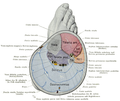Tibialis anterior muscle
| Tibialis anterior muscle | |
|---|---|
| Identifiers | |
| Latin | musculus tibialis anterior |
| TA98 | A04.7.02.037 |
| TA2 | 2644 |
| FMA | 22532 |
| Anatomical terms of muscle] | |
The tibialis anterior muscle is a
It is situated on the lateral side of the tibia; it is thick and fleshy above, tendinous below. The tibialis anterior overlaps the
Structure
The tibialis anterior muscle is the most medial muscle of the
The muscle ends in a tendon which is apparent on the anteriomedial dorsal aspect of the foot close to the ankle.[citation needed] Its tendon is ensheathed in a synovial sheath. The tendon passes through the medial compartment superior and inferior extensor retinacula of the foot.[2]
Origin
The tibialis anterior muscle arises from the upper 2/3 of the lateral surface of the tibia and
Insertion
It is inserted into the medial and inferior surface of the
Nerve supply
The tibialis anterior muscle is innervated by the deep fibular nerve, and recurrent genicular nerve (L4).[2]
Variation
A deep portion of the muscle is rarely inserted into the
The tibiofascialis anterior, a small muscle from the lower part of the tibia to the transverse or cruciate crural ligaments or deep fascia.[clarification needed]
Actions/movements
The muscle acts to
Function
The muscle helps maintain the
The movements of tibialis anterior are
Clinical significance
A tibialis anterior hernia is a rare type of hernia in which fat or other material protrudes through a defect in the tibialis anterior muscle.[6] It may be caused by trauma, such as an inadvertent kick to the lower leg from an opposing player in a football match.[citation needed]
Additional images
medial view of dissected ankle has two muscles
-
Lateral aspect of right leg.
-
Tibialis anterior muscle
-
Cross-section through top third and second third of right leg.
-
Tibialis anterior muscle
-
Ankle joint. Deep dissection. Lateral view *This has some structures labelled incorrectly e.g. tibialis anterior, extensor hallucis longus and cuboid bone
See also
References
![]() This article incorporates text in the public domain from page 480 of the 20th edition of Gray's Anatomy (1918)
This article incorporates text in the public domain from page 480 of the 20th edition of Gray's Anatomy (1918)
- ^ ISBN 978-1-4377-0927-8, retrieved 2021-03-01
- ^ ISBN 978-0-7295-3752-0.
- ISBN 978-0-443-06644-3, retrieved 2021-03-01
- ^ "10 Incredible Tibialis Raise Benefits". 2022-04-08. Retrieved 2023-09-28.
- ISSN 0021-9290.
- PMID 27999130.
External links
- Anatomy photo:15:st-0415 at the SUNY Downstate Medical Center
- Tibialis Anterior from Wheeless' Textbook of Orthopaedics




